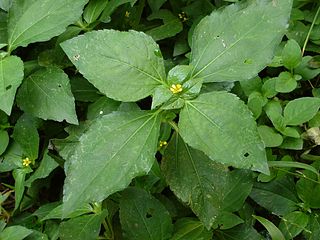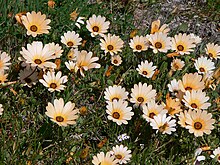
Grindelia (gumweed) is a genus of plants native to the Americas belonging to the family Asteraceae. The genus was named for Latvian botanist David Hieronymus Grindel, 1776–1836.
Acanthospermum humile is a species of plants in the family Asteraceae. It is native to the West Indies but naturalized in parts of South America, Central America, and North America.
Oblivia is a genus of flowering plant in the tribe Heliantheae within the family Asteraceae.

Pseudogynoxys is a genus of flowering plant in the groundsel tribe within the sunflower family, native to North and South America.

Acourtia is a genus of flowering plants in the family Asteraceae and was first described as a genus in 1830. It includes desertpeonies, such as Acourtia nana and Acourtia runcinata.

Spermacoce or false buttonweed is a genus of flowering plants in the family Rubiaceae. It comprises about 275 species found throughout the tropics and subtropics. Its highest diversity is found in the Americas, followed by Africa, Australia and Asia.

Pittocaulon is a genus of Mexican shrubs and small trees in the tribe Senecioneae within the family Asteraceae.
Critoniadelphus is a genus of flowering plants in the family Asteraceae.
Trigonospermum is a genus of Mesoamerican plants in the family Asteraceae.
Espejoa is a genus of Mesoamerican flowering plants in the daisy family.

Gymnosperma is a genus of North American flowering plants in the family Asteraceae.
Westoniella is a genus of Costa Rican shrubs in the tribe Astereae within the family Asteraceae.
Wamalchitamia is a genus of Mesoamerican flowering plants in the family Asteraceae.
Spiracantha is a genus of flowering plants in the tribe Vernonieae within the family Asteraceae.

Synedrella is a genus of flowering plants in the family Asteraceae.
Philactis is a genus of Mexican plants in the tribe Heliantheae within the family Asteraceae.
Trixis inula, the tropical threefold, is a plant species native to Texas, Mexico, Central America, northern South America, and the West Indies. It is found on open, sandy sites such as roadsides, thorn scrub, thickets, etc.

Ardisia escallonioides, the Island marlberry, is a plant species native to the West Indies and neighboring areas. It has been reported from Barbados, Bermuda, the Dominican Republic, Cuba, Mexico, Belize, Guatemala and Florida.
Chaptalia albicans, the white sunbonnet, is a plant species native to Mexico, Central America and the West Indies. It is known from Jamaica, Cuba, Guatemala, Belize, Honduras, southern Florida, the Bahamas, Hispaniola, Puerto Rico, San Luis Potosí, Veracruz, Yucatán, Campeche and Chiapas.

Cirsium horridulum, called bristly thistle, purple thistle", or "yellow thistle is a North American species of plants in the tribe Cardueae within the family Asteraceae. It is an annual or biennial. The species is native to the eastern and southern United States from New England to Florida, Texas, and Oklahoma as well as to Mexico, Belize, Guatemala, Honduras, and the Bahamas.









